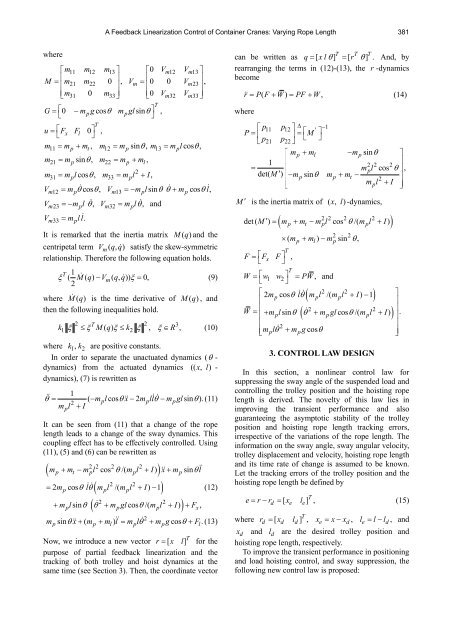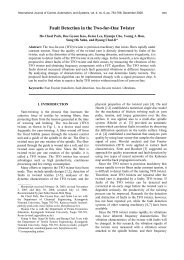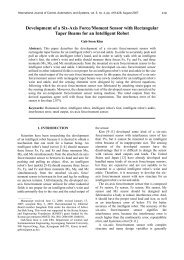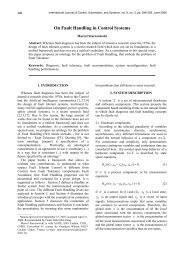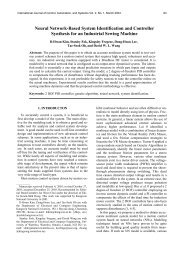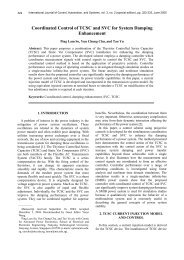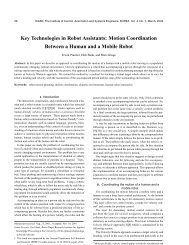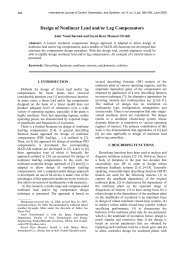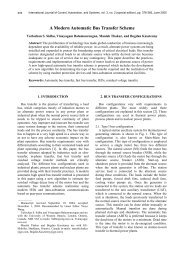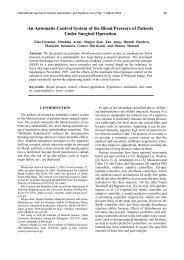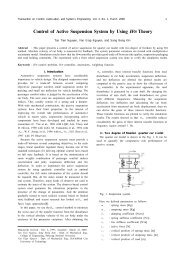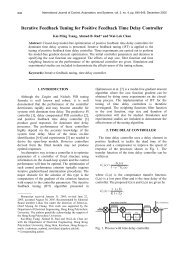A Feedback Linearization Control of Container Cranes ... - IJCAS
A Feedback Linearization Control of Container Cranes ... - IJCAS
A Feedback Linearization Control of Container Cranes ... - IJCAS
You also want an ePaper? Increase the reach of your titles
YUMPU automatically turns print PDFs into web optimized ePapers that Google loves.
A <strong>Feedback</strong> <strong>Linearization</strong> <strong>Control</strong> <strong>of</strong> <strong>Container</strong> <strong>Cranes</strong>: Varying Rope Length 381where⎡m m m ⎤M m m 0 ,11 12 13=⎢⎥⎢ 21 22 ⎥⎢m31 0 m33⎥⎣G = ⎡0 −mpgcosθmpglsin θ⎤,⎣⎦T⎦V⎡0V V ⎤0 0 ,m12 m13m =⎢V⎥⎢ m23⎥⎢0Vm32 Vm33⎥u = ⎡F x Fl0 ⎤ ,⎣ ⎦m = m + m m12 = m sin θ , m13 = m lcos θ ,11 p t ,m21 = mpsin θ,m22 = mp+ ml,p⎣233 = p + ,m31 = mplcos θ,m m l IVm12 = m pθ cos θ,Vm13 =− mplsin θ θ + mpcos θl,VVm23 mpl θ,=− V 32 = m lθ , andm33 mpll.= mpIt is remarked that the inertia matrix M ( q)and thecentripetal term Vm( q, q ) satisfy the skew-symmetricrelationship. Therefore the following equation holds.T 1ξ ( M ( q) − Vm( q, q)) ξ = 0,2 (9)where M ( q)is the time derivative <strong>of</strong> M ( q ) , andthen the following inequalities hold.2 T21 ξ ≤ξ ξ ≤ 2 ξk M( q) k ,Tpξ ∈ R 3 , (10)where k1,k 2 are positive constants.In order to separate the unactuated dynamics (θ -dynamics) from the actuated dynamics (( x, l)-dynamics), (7) is rewritten as 1θ = ( −ml p cosθ x−2mllp θ −mglp sin θ).(11)ml + I2pIt can be seen from (11) that a change <strong>of</strong> the ropelength leads to a change <strong>of</strong> the sway dynamics. Thiscoupling effect has to be effectively controlled. Using(11), (5) and (6) can be rewritten as2 2 2 2( p + t − p θ p + ) + p2 2= 2mpcos θ l θ( ml p /( ml p + I) −1)2 2θ ( θ θ )m m ml cos /( ml I) x m sinθl+ ml p sin + mgl p cos /( ml p + I) + Fx,2m sin θ x+ ( m + m ) l = m l θ + m gcos θ + F.(13)p p l p p l⎦(12)Now, we introduce a new vector r = [ x l] T for thepurpose <strong>of</strong> partial feedback linearization and thetracking <strong>of</strong> both trolley and hoist dynamics at thesame time (see Section 3). Then, the coordinate vectorT T Tcan be written as q = [ xlθ] = [ r θ ] . And, byrearranging the terms in (12)-(13), the r -dynamicsbecome r = P( F + W) = PF + W,(14)where⎡p11 p12 ⎤ ∆'−1P = ⎢ Mp21 p⎥ = ⎡ ⎤⎣ 22 ⎦⎣ ⎦⎡ mp + ml −mpsinθ⎤1 ⎢⎥2 2 2= ⎢ ml p cos θ ⎥ ,det( M ′) ⎢− mpsinθmp + mt−2⎥⎢⎣ml p + I ⎥⎦M ′ is the inertia matrix <strong>of</strong> ( x, l)-dynamics,2 2 2 2( p t p θ p )det ( M ′) = m + m − m l cos /( m l + I)p l2p2= ⎡ ⎣T⎤x , ⎦= ⎡T⎤1 2 = , andF F F× ( m + m ) −msin θ,W w w PW⎣ ⎦⎡2 22mpcos θ l θ( ml p /( ml p + I) −1⎢)W =⎢2 2+ ml p sin θ ⎢θ + mgl p cos θ /( ml p + I)⎢2⎢ml⎣ p θ + mg p cosθ( )3. CONTROL LAW DESIGNIn this section, a nonlinear control law forsuppressing the sway angle <strong>of</strong> the suspended load andcontrolling the trolley position and the hoisting ropelength is derived. The novelty <strong>of</strong> this law lies inimproving the transient performance and alsoguaranteeing the asymptotic stability <strong>of</strong> the trolleyposition and hoisting rope length tracking errors,irrespective <strong>of</strong> the variations <strong>of</strong> the rope length. Theinformation on the sway angle, sway angular velocity,trolley displacement and velocity, hoisting rope lengthand its time rate <strong>of</strong> change is assumed to be known.Let the tracking errors <strong>of</strong> the trolley position and thehoisting rope length be defined byTd e e⎤⎥⎥⎥.⎥⎥⎦e= r− r = [ x l ] ,(15)Twhere rd = [ xd ld] , xe= x− xd,le= l − ld,andx d and l d are the desired trolley position andhoisting rope length, respectively.To improve the transient performance in positioningand load hoisting control, and sway suppression, thefollowing new control law is proposed:


